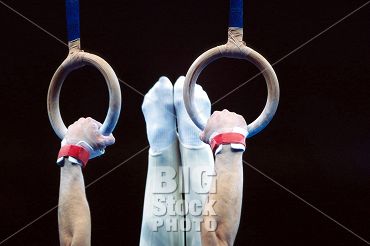Physical therapy in Downtown Birmingham and onsite at American Cast Iron and Pipe for Dance and Gymnastics

Picture: Bigstock # 1252565
Welcome to Iron City Physical Therapy's guide for selecting personal gymnastic gear. We recommend a few general considerations for selecting your gear in order to stay comfortable and help minimize injury. Clothing:
Most likely your club will specify your clothing requirements, usually a leotard or gym shorts and singlet top for females, and gym shorts and t-shirt or singlet for males. Tight fitting, comfortable clothing is necessary to allow you freedom to move without catching clothing on equipment.
Grips and Wrist Bands:
Leather "grips" are often used to protect your palms from calluses and rips (torn blisters) caused by friction on your hands from uneven bars, parallel bars, rings or the high bar. They are not always used, some gymnasts or their coaches, prefer to toughen up the hand. At beginner levels they are not usually required. Grips come with or without dowels that help to grip the bars. Progression to grips and the selection of grip type and brand will be guided by your coach. New grips will require breaking in - when wearing new grips practice easier skills until you are comfortable with the new grips. Keep your old grips for the more difficult skills in the mean time.
Wrist Bands, usually made from cotton or neoprene, are worn under grips to prevent chaffing.
Shoes:
There are a variety of gymnastic shoes available for different disciplines. They are optional. The benefits of wearing each type of shoe are listed below. The disadvantages of wearing gymnastic shoes are that they can draw attention to your feet and that they can reduce your proprioception - the feel of your feet on the floor, mat or beam.
"Beam Shoes" are tight slippers with traction on the sole to prevent slipping. They can provide some cushioning for your feet.
"Apparatus Shoes" are very light, with traction on the soles of the feet to prevent slipping on dismounts only.
"Vault Shoes" have padded soles providing shock absorption for your feet upon landing.
"Floor Shoes" vary depending on your floor routine. If you favour lots of tumbling, you may prefer a padded shoe for shock absorption. If your routine includes lots of dance moves you'll probably prefer a shoes that allows your foot to slide.
Hydration:
Keeping hydrated will help you stay alert while training or competing, may help to prevent muscle cramps and will help your post-training or competition recovery. Take your own drink bottles so that you can monitor your fluid consumption. We recommend that you drink about 300-400 mL before arriving at training or a competition (ref: http://www.ausport.gov.au/sportscoachmag/nutrition2/pre-event_nutrition), and 250mL (1 cup) of water or sports drink every 20 minutes during training and for one hour after training. Your fluid requirements will vary depending on the environmental conditions and your body size. To check that you are adequately hydrating, you can weigh yourself before and after you train. If your weight remains the same then you are likely to be well hydrated.




